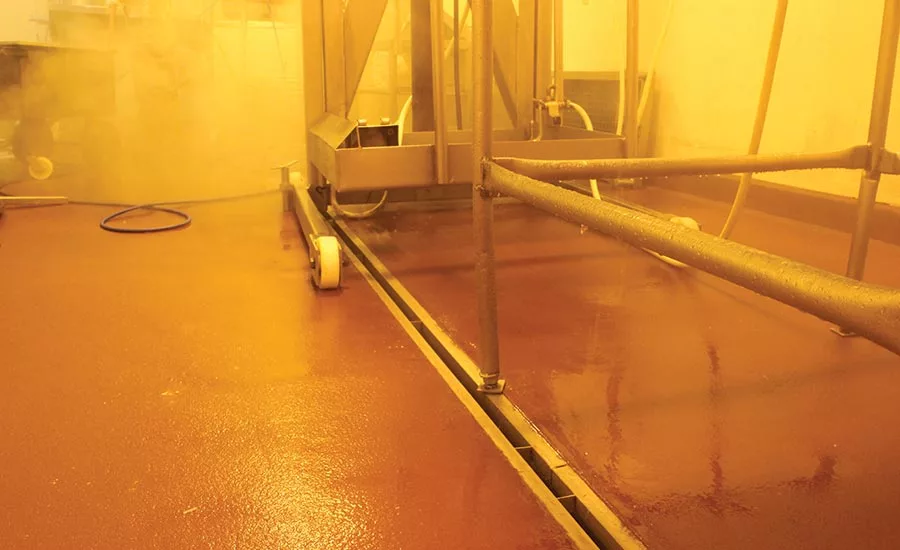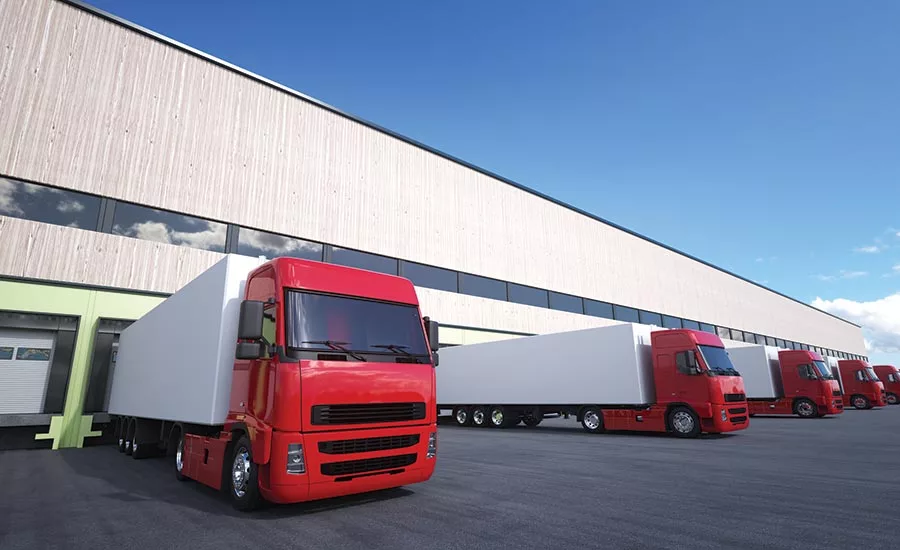Food Safety
Expert advice on sanitary plant design
Experts offer practical, realistic advice for implementing sanitary plant design in both new and existing facilities.

When it comes to sanitary design, water can be a big issue. Factories should check to make sure even water-tight seals aren’t actually letting in any contaminants.

Slot Drain manufactures a line of stainless steel trench drains for food and beverage manufacturers that routinely need to pass sanitation and safety audits. Source: Slot Drain.


Slot Drains’ stainless steel trench drains are not grated, so they don't attract and house bacteria. Source: Slot Drain.
Jim Tonjes, former vice president of engineering for General Mills, recalls when he was asked to head the food safety program for that company just as FSMA was kicking into high gear.
“We had all the quality [assurance] people from the whole corporation in every single factory go through and come up with a list of what they thought could be a potential problem in their factory,” he recalled during a speech at Food Engineering’s 2017 Food Automation and Manufacturing Conference. “Well, that being said, it came back that the list was 10 miles long.”
Then, the CEO stepped in.
“[He] said to me, ‘I want you to take care of every single issue we’ve got in the whole corporation,’” Tonjes says.
So, over the course of the next two years, that’s exactly what he did. And during that time, he also decided to help other companies do the same and began giving educational speeches on the topic.
At one of those speeches, there was an audience member who served on the Obama council for food safety. After the presentation, the man raised his hand.
“He said, ‘I have to really compliment you and the company for what you’ve done to identify all these things,’” Tonjes says. “‘If you now so choose not to address any of those issues, we’ve got you.’”
The government representative went onto explain that the key to staying out of trouble is to address any potential food safety issue and keep a good paper trail showing every attempt was made to fix that issue. But if the decision was made not to spend money and something happens, that’s when the government will fine you. That comment has always stuck with Tonjes as conveying the importance of addressing sanitation issues.
Article Index:
To build or fix
The first thing a lot of companies have to consider when taking all this in is whether to build a new factory or fix an existing one.
“Along with the usual business case, such as ROIs and IRR thresholds, possibly the single biggest consideration that food processors need to factor into their new facility or upgrade plans is the limitations of their existing facilities,” says Tyler Cundiff, director of business development at Gray Construction, a design-build firm. “Fixing flaws in existing facilities will prove to be expensive and time consuming to correct while keeping the facility operational.”
Chris Jarc, vice president and project manager at Hixson Architecture & Engineering, says sanitary designs are possible in both new and renovated facilities, but existing facilities may contain food safety risks that are impractical or cost prohibitive to eliminate.
“It is easier to implement the most advanced sanitary design solutions in a new factory,” Jarc explains. “Yet, replacing an existing factory with a new one is an expensive proposition. Companies should assess the food safety risks in their existing facility and determine whether they can be cost-effectively mitigated. Each company’s capital expenditures and specific processing needs will drive how sanitary the facility can and should be.”
Following the water
According to Tonjes, important for the sanitary design of plants, whether new or rehabilitated, is to “follow the water.” He explains that water will migrate wherever it can go down through the floor, including through the cracks. And he has even seen water migrate as much as four floors down.
“Water is your number one problem, no matter where you go. It’s process cleaning, roof leaks, wall moisture, floor cracks, floor tiles,” he says. “If you identify what your enemy is, then you [can] start to focus your building design around that.”
For example, while Tonjes was at General Mills, the company actually dissected pieces of equipment to find potential problems and found the water-tight seals on bearings weren’t effective.
“We actually cut bearings in two that had been on mixers for years, and they were so full of material, it was amazing … and it was a certified water-tight seal.”
Tonjes says he has also seen factories ignore things like roof leaks, which can lead to a lot of negative consequences, such as contamination issues.
Industrial enclosures, such as the ones made by Rittal, can help with water-related issues. They are designed to withstand the rigors of frequent washdowns, including those using high-pressure and high-temperature water, and aggressive cleaning agents.
For example, OSI Food Solutions Germany uses Rittal’s HD enclosures in a facility that produces 5.5 million hamburger patties a day. The blue silicone door seal allows its workers to spot dirty seals and replace them as needed.
OSI found that the enclosures worked so well—specifically their ability to be leak tight and resist cleaning chemicals of the HD line—that it now specifies the HD line as the standard for new machines and plants within their operations.
Another item that comes in constant contact with water and is important to sanitary plant design, but often gets overlooked, is drains.
Slot Drain manufactures a line of stainless steel trench drains for food and beverage manufacturers that routinely need to pass sanitation and safety audits. Unlike traditional grated drains, which attract and house bacteria, Slot Drain products are fabricated from hygienic stainless steel and have CIP capabilities and cleaning accessories, ensuring sanitation.
“The drain will fill itself, allowing for a sanitizer rinse to reach all parts of the drain body,” the company says. “Once the rinse is released, the brush and paddle sanitizing accessories are used to scrub the drains. When done effectively, it [the process] destroys bacteria, fruit flies and other microorganisms. The entire process takes a fraction of the time, effort and daily labor expense of grated trench drain systems.”
Sources of contamination
To help prevent outside pathogens from coming in, manufacturers must take a hard look at how ingredients and materials are entering their facilities.
“Ingredients play a huge factor in your food safety now,” Tonjes says.
If contaminated materials do enter the plant, they have the potential of contaminating the factory, so there must be a clear set of rules. In fact, many plants are disinfecting trucks as they enter their property to control the microbes that may or may not be on the trucks themselves. Tonjes knows of a water bottling factory that did this.
“They had 40 tankers per day coming into this facility, and they were basically going through a complete truck wash and sanitizing system before they were even allowed to enter the site,” he says.
There’s another outside source of contamination that is sometimes not considered—visitors. Tonjes says it is important for all people who enter the plant floor to follow the sanitation rules, whether they are workers, visitors or executives from headquarters.
“I’ve seen that, where they say, ‘Oh, don’t worry about it. You’re fine. Let’s go through.’ No, you have to really be stringent,” Tonjes says.
Once a company determines the factory’s problems, the next step is to prioritize the to-do list.
“You have to rate the potential issues, as far as food safety, allergens, explosive capabilities, that type of thing,” Tonjes says.
But addressing any sanitation issue requires one very important thing—management buy-in.
“If you don’t have management support directing people to take action against all these different items, basically it won’t happen,” Tonjes explains, “because people say, ‘OK, I don’t want to spend the money, [and] it’s not being pushed by management,’ and so basically, you lose a lot of that emphasis.”
He knows first-hand how beneficial taking action can be.
“When I was at General Mills … the CEO himself said to me, ‘Your job isn’t correcting all these food safety issues; your job is to help me sleep better at night,’” he recalls. “When we accomplished that whole task, he said, ‘Boy, I do sleep very well now.’”
For more information:
To watch all of Jim Tonjes’ speech at the Food Automation and Manufacturing conference, as well as many of the other speeches from the show, for free, visit http://www.foodautomationconference.com and click on the Broadcast Live banner.
Tyler Cundiff, Gray Construction,
www.gray.com/projects/food-and-beverage-plant-construction, tcundiff@gray.com
Chris Jarc, Hixson Architecture & Engineering,
513-241-1230, www.hixson-inc.com
John Carnevale, Rittal,
224-220-4869, Carnevale.J@rittal.us
Slot Drain, 855-497-7508,
www.slotdrainsystems.com
Steps for addressing sanitary design
Chris Jarc, vice president and project manager of Hixson Architecture & Engineering, offers some specific tips for what he believes are the most important aspects of sanitary design.
When creating a sanitary design, he says flexibility must be weighed against durability, so that facilities can accommodate rapid changes, but not at the expense of cleanable environments.
Some key factors that should be addressed through sanitary design include:
- Establish zones of control. Zones ideally should be established beginning at the facility’s property line. Additional protections should then be created to prevent any hazards that do get in from transferring between areas. The idea of zones of control is similar to that of a cocoon: With zones of control, you are trying to protect the core areas of the plant where the ready-to-eat (RTE) product is located, especially when it is in an open environment, such as filling or packaging.
- Manage the flow of people and materials. Most facilities are aware there are production workers whose movements must be controlled (for example, keeping raw workers out of RTE spaces). Yet, there are many others (e.g., maintenance workers and quality assurance personnel) who may also be capable of transferring pathogens, allergens and microbes. Materials are another aspect: If maintenance personnel must continually cross through the raw area to gather spare parts for RTE, the risk for contamination rises. Controlling the movements of people ideally should be a true physical barrier, not just a suggestion of one, such as a line painted on a floor or rope barriers. Access control card readers, magnetic locks and even doors can all be used to actively separate spaces and prevent workers from crossing into spaces where they should not be.
- Take control of the environment. Typically, this includes air make up, exhaust, HVAC and refrigeration for each space. For each of the zones of control, facilities must determine what methods are required to manage factors such as moisture/water, temperature and humidity and air balance and quality. Some zones will obviously be more critical than others and will require a higher level of control.
- Determine automation levels. Automation can help address some of the contamination risks as well by minimizing the number of people required to operate a line, thus lessening risk.
Looking for a reprint of this article?
From high-res PDFs to custom plaques, order your copy today!







